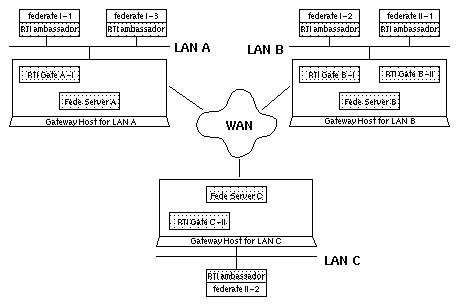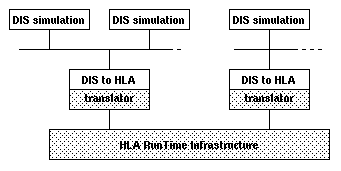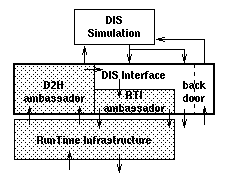The GMU RTI Home Page |
||||
| [The RTI] | [Download the RTI] | [DIS to HLA] | [Download the translator] | [Papers] |
The RTIPresentationIn order to understand the HLA and bring our work into compatibility with it, we have been investigating design and implementation alternatives for a light-weight RTI to be used with distributed virtual simulation (see 97F-SIW-149). It focuses on Declaration Management and the Data Distribution Management issues. Our RTI prototype grew out of earlier works. The interest and data distribution management part is based on the Dual Mode Multicast (DMMC) scheme, and the communications portion includes the Selectively Reliable Transmission Protocol (SRTP). ArchitectureOur RTI has a distributed architecture. The different components are connected together using TCP to send and receive the services information (which must be delivered reliably and are rather infrequent) and using SRTP to send and receive simulation data.
 RTI Network with 3 LANs (A, B and C) and 2 federations (I and II) The main components of the RTI are:
This implementation is based on the version 1.1 of the RTI specifications, but several modifications have been made to the Declaration Management and to the Data Distribution Management in order to prepare the migration to the version 1.2 and to fix several inconsistencies. Downloading
You can download the documentation and the
source code from here.
| |
|
| |
The DIS to HLA translatorPresentationIn order to test our implementation of the HLA Run Time Infrastructure at a real scale, it was necessary to have a federate which is able to generate attribute updates and interactions and to simulate a large number of entities. The DIS to HLA translator was developped to make ModSAF work with the RTI and to provide the federate we needed. Architecture
 Architecture of the DIS to HLA translator The DIS to HLA translator is an independent piece of software, and can be used without modifying the presentation and transport layers of ModSAF. This translator sends/receives PDUs like a DIS simulation, converts them into RTI service requests and sends/receives RTI requests like a federate. This first version is only able to handle Entity State PDUs and a few others interaction PDUs. Experimental and other unprocessed PDUs are just forwarded through a ``back-door''.
 Exchange of data between the different components Three different modules work together in the translator. The RTI ambassador and the Federate ambassador (called D2H ambassador) are the interface with the HLA RTI. The DIS interface receives information from the DIS simulations and turn them into HLA services. The back door transmits all the other information received from ModSAF. Downloading
You can download the documentation and the source code from here.
| |
|
| |
|
mpullen@gmu.edu
mmoreau@bacon.gmu.edu
Last updated on 08/19/1997 |
|